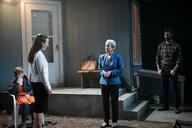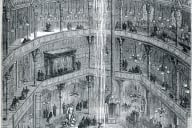You have /5 articles left.
Sign up for a free account or log in.
Last week, Intellectual Affairs gave the recent cable TV miniseries “Sex: The Revolution” a nod of recognition, however qualified, for its possible educational value. The idea that sex has a history is not, as such, self-evident. The series covers the changes in attitudes and norms between roughly 1950 and 1990 through interviews and archival footage. Most of this flies past at a breakneck speed, alas. The past becomes a hostage of the audience’s presumably diminished attention span.
Then again, why be ungrateful? Watching the series, I kept thinking of a friend who teaches history at Sisyphus University, a not-very-distinguished institution in the American heartland. For every student in his classroom who seems promising, there are dozens who barely qualify as sentient. (It sounds like Professor X, whose article “In the Basement of the Ivory Tower” appears in the latest issue of The Atlantic, teaches in the English department there.) Anything, absolutely anything, that might help stimulate curiosity about the past would be a godsend for the history faculty at Sisyphus U.
With that consideration in mind, you tend to watch “Sex: The Revolution” with a certain indulgence -- as entertainment with benefits, so to speak. Unfortunately, the makers stopped short. They neglected to interview scholars who might have provided more insight than a viewer might glean from soundbites by demi-celebrities. And so we end up with a version of history not too different from the one presented by Philip Larkin in the poem “Annus Mirabilis” --
Sexual intercourse began
In nineteen sixty-three
(Which was rather late for me) -
Between the end of the Chatterley ban
And the Beatles' first LP.
-- except without the irony. A belief that people in the old days must have been repressed is taken for granted. Was this a good thing or not? Phyllis Schlafly and reasonable people may disagree; but the idea itself is common coin of public discourse.
But suppose a television network made a different sort of program -- one incorporating parts of what one might learn from reading the scholarship on the history of sex. What sense of the past might then emerge?
We might as well start with the Puritans. Everybody knows how up-tight they were -- hostile to sex, scared of it, prone to thinking of it as one of the Devil’s wiles. The very word “Puritan” now suggests an inability to regard pleasure as a good thing.
A case in point being Michael Wigglesworth -- early Harvard graduate, Puritan cleric, and author of the first American best-seller, The Day of Doom (1642), an exciting poem about the apocalypse. Reverend Wigglesworth found the laughter of children to be unbearable. He said it made him think of the agonies of the damned in hell.You can just imagine how he would respond to the sound of moaning. Somehow it is not altogether surprising to learn that the Rev’s journal contains encrypted entries mentioning the “filthy lust” he felt while tutoring male students.
In short, a typical Puritan -- right? Well, not according to Edmund Morgan, the prominent early-Americanist, whose many contributions to scholarship over the years included cracking the Wigglesworth code. (He is now professor emeritus of history at Yale.)
Far from being typical, Wigglesworth, it seems, was pretty high-strung even by the standards of the day. In a classic paper called “The Puritans and Sex,” published in 1942, Morgan assessed the evidence about how ordinary believers regarded the libido in early New England. He found that, clichés notwithstanding, the Puritans tended to be rather matter-of-fact about it.
Sermons and casual references in letters and diaries reveal that the Puritans took sexual pleasure for granted and even celebrated it -- so long, at least, as it was enjoyed within holy wedlock. Of course, the early colonies attracted many people of both sexes who were either too young to marry or in such tight economic circumstances that it was not practical. This naturally meant a fair bit of random carrying on, even in those un-Craigslist-ed days. All such activity was displeasing unto the Lord, not to mention His earthly enforcers; but the court records show none of the squeamishness about that one might expect, given the Puritans’ reputation. Transgressions were punished, but the hungers of the flesh were taken for granted.
And Puritan enthusiasm for pleasures of the marriage bed was not quite so phallocentric as you might suppose. As a more recent study notes, New Englanders believed that both partners had to reach orgasm in order for conception to occur. Many Puritan women must have had their doubts on that score. Still, the currency of that particular bit of misinformation would tend to undermine the assumption that everybody was a walking bundle of dammed-up desire -- finding satisfaction only vicariously, through witch trials and the like.
Our imagined revisionist documentary would be full of such surprises. Recent scholarship suggests that American mores were pretty wild long before Alfred Kinsey quantified things in his famous reports.
Richard Godbeer’s Sexual Revolution in Early America (Johns Hopkins University Press, 2002) shows that abstinence education was not exactly the norm in the colonial period. Illegitimate births were commonplace; so was the arrival of children six or seven months after the wedding day. For that matter, cohabitation without benefit of clergy was the norm in some places. And while there were statutes on the books against sodomy -- understood as nonprocreative sexual activity in general -- it’s clear that many early Americans preferred to mind their own business.
Enforcing prohibitions on “unnatural acts” between members of the same sex was a remarkably low priority. “For the entire colonial period,” noted historians in a brief filed a few years ago when Lawrence v. Texas went to the U.S. Supreme Court, “we have reports of only two cases involving two women engaged in acts with one another.... The trial of Nicholas Sension, a married man living in Westhersfield, Connecticut, in 1677, revealed that he had been widely known for soliciting sexual contacts with the town’s men and youth for almost forty years but remained widely liked. Likewise, a Baptist minister in New London, Connecticut, was temporarily suspended from the pulpit in 1757 because of his repeatedly soliciting sex with men, but the congregation voted to restore him to the ministry after he publicly repented.”
History really comes alive, given details like that -- and we’ve barely reached the Continental Congress. The point is not that the country was engaged in one big orgy from Plymouth Rock onwards. But common attitudes and public policies were a lot more ambivalent and contradictory in the past than we’re usually prone to imagine.
There was certainly repression. In four or five cases from the colonial era, sodomy was punished by death. But in a society where things tend to be fluid -- where relocation is an option, and where money talks -- there will always be a significant share of the populace that lives and acts by its own lights, and places where the old rules don't much matter. And so every attempt to enforce inhibition is apt to seem like little, too late (especially to those making the effort).
You catch some of that frantic sense of moral breakdown in the literature of anti-Mormonism cited by Sarah Barringer Gordon in her study The Mormon Question: Polygamy and Constitutional Conflict in Nineteenth-Century America, published by the University of North Carolina Press in 2002. Novels about polygamous life in Utah were full of dark fascination with the lascivious excess being practiced in the name of freedom of religion – combined with fear that the very social and political order of the United States was being undermined. It was all very worrying, but also titillating. (Funny how often those qualities go together.)
The makers of “Sex: The Revolution” enjoyed the advantage of telling stories from recent history, which meant an abundance of film and video footage to document the past. Telling a revisionist story of American sexual history would suffer by visual comparison, tending either toward History Channel-style historical reenactments or Ken Burns-ish readings of documents over sepia-toned imagery.
But now, thanks to the efforts of phonographic archivists, we can at least listen to one part of the sexual discourse of long ago. A set of wax recordings from the 1890s -- released last year on a CD called “Actionable Offenses” -- preserves the kind of lewd entertainment enjoyed by some of the less respectable Americans of the Victorian era. And by “lewd,” I do not mean “somewhat racy.” The storytelling in dialect tends to be far coarser than anything that can be paraphrased in a family publication such as Inside Higher Ed. A performance called “Learning a City Gal How to Milk” is by no means the most obscene.
Anthony Comstock -- whose life’s work it was to preserve virtue by suppressing vice -- made every effort to wipe out such filth. It’s a small miracle that these recordings survived. The fact that they did gives us a hint at just how much of a challenge Comstock and associates must have faced.
When a popular program such as “Sex: The Revolution” recalls the past, it is usually an account of the struggle to free desire from inhibition. Or you can tell the same tale in a conservative vein: the good old days of restraint, followed by a decline into contemporary decadence.
Both versions are sentimental; both condescend to the past.
In the documentary I’d like to see, the forces of repression would be neither villains nor heroes. They would be hapless, helpless, confused -- and sinking fast in quicksand, pretty much from the start. It would be an eye-opening film. Not to mention commercially viable. After all, there would be a lot of sex in it.




